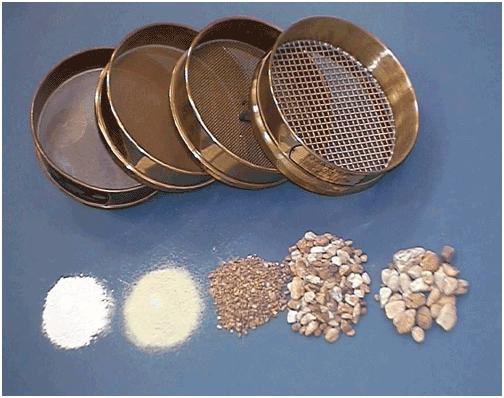Objective
For the assessment of the particle size distribution of the specified fine aggregate and for determination of the fineness modulus, the effective size and uniformly coefficient.
Theory
Fine aggregate refers to the sand which is basically utilized in mortars. Coarse aggregate is the broken stone which is utilized in concrete. The coarse aggregate when is not blended with fine aggregate has no specific purpose in cement works. The volume of fine aggregate does not exceed the maximum of 4.75 mm gauge and when it becomes greater that, it is called as coarse aggregate.
Limit of Fineness Modulus:
| Maximum size of aggregate | ||
| Minimum | Maximum | |
| Fine Aggregate | 2 | 3.5 |
| Coarse aggregate 20mm | 6 | 6.9 |
| Coarse aggregate 40mm | 6.9 | 7.5 |
| Coarse aggregate 75mm | 7.5 | 8.0 |
In such cases where the test aggregate yields higher fineness modulus the blend will be hard and in case where it provides a lower fineness modulus it provides a not very cost effective mix.
Effective Size
Effective size (in microns) refers to the greatest particle size of the minimum 10% of the total or it is the sieve opening consistent to 10% finer and is nominated by the symbol D10.
Uniformity Coefficient
This is the proportion of the greatest size of the smallest 60% to the operational size .
Uniformity coefficent = D60/D10
Apparatus
- Indian standard test sieves
- weighing balance
- sieve shaker
The different sizes of sieves to be utilized for the process
(I) for fine aggregate- 4.75mm, 2.36mm, 1.18mm, 600 microns, 300microns ,150microns.
(II) For coarse aggregate-25mm,20mm 12.5mm, 10mm, 4.75mm
Procedure
Fine Aggregate:
(i) First of all, take one kg of sand from the laboratory specimens.
(ii)Organize the sieves in order of IS sieves no’s 480, 240, 120, 60, 30 and additionally 15, Putting sieve no.480 at the crest and 15 at the base and then cover up the top part.
(iii)Put the specimen in the top sieve no.480.
(iv) Conduct the process of sieving in the set of sieves for a minimum of 10 minutes.
(v) Assess the weight of specimen reserved in each of the sieves.
(vi) Tabularize the values in specified tabular form.
Coarse Aggregates:
(i)First of all, take one kg of coarse aggregate
(ii) Organize the sieves in such a way that they are one over the other in accordance to their size of opening. (25mm,20mm,12.5mm10mm,4.75mm)
(iii Conduct the process of sieving for the allotted period of time.
(iv) Assess the weight of agggregate reserved on each one of sieves carried out in order and tabularize in table.
Graph
Illustrate a graph with sieve opening to log scale on the X-axis and % finer on Y-axis. The curve is known as the grading curve.
Calculation
Fine Aggregate:
1. Suitable size in microns(Di0 sieve opening corresponding to 10%finer in the graph ) =
2. Uniformity coefficient (D60/ D10),D to be recieved from the graph ) =
3. Fineness modulus (Total of cumulative % wt retained /100) =
Coarse Aggregate:
1. Suitable dimensions in microns (D10,sieve opening corresponding to 10% finer in the graph)
2. Uniformity coefficient (D60/ D10),D to be received from the graph ) =
3. Fineness modulus (Total of cumulative % wt retained /100) =
Results
Fine Aggregate:
1. Effective size =………micron
2. Uniformity coefficient =
3. Fineness modulus =
Coarse Aggregate:
4. Effective size =………micron
5. Uniformity coefficient =
6. Fineness modulus =

